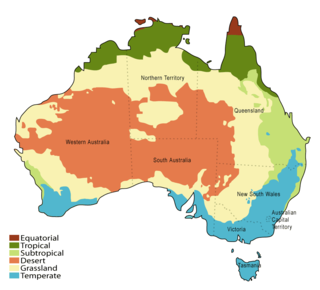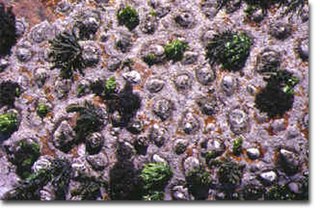List of seaweeds of South Africa may refer to one of:
List of seaweeds of South Africa may refer to one of:

Algae is an informal term for a large and diverse group of photosynthetic eukaryotic organisms. It is a polyphyletic grouping that includes species from multiple distinct clades. Included organisms range from unicellular microalgae, such as Chlorella, Prototheca and the diatoms, to multicellular forms, such as the giant kelp, a large brown alga which may grow up to 50 metres (160 ft) in length. Most are aquatic and autotrophic and lack many of the distinct cell and tissue types, such as stomata, xylem and phloem, which are found in land plants. The largest and most complex marine algae are called seaweeds, while the most complex freshwater forms are the Charophyta, a division of green algae which includes, for example, Spirogyra and stoneworts.

Kelps are large brown algae seaweeds that make up the order Laminariales. There are about 30 different genera. Despite its appearance, kelp is not a plant; it is a heterokont.
Carrageenans or carrageenins are a family of natural linear sulfated polysaccharides that are extracted from red edible seaweeds. The most well-known and still most important red seaweed used for manufacturing the hydrophilic colloids to produce carrageenan is Chondrus crispus which is a dark red parsley-like plant that grows attached to the rocks. Carrageenans are widely used in the food industry, for their gelling, thickening, and stabilizing properties. Their main application is in dairy and meat products, due to their strong binding to food proteins. In recent years, carrageenans have emerged as a promising candidate in tissue engineering and regenerative medicine applications as they resemble native glycosaminoglycans (GAGs). They have been mainly used for tissue engineering, wound coverage and, drug delivery.

Hairspray is an American musical with music and lyrics by Marc Shaiman and Scott Wittman and a book by Mark O'Donnell and Thomas Meehan, based on John Waters's 1988 film of the same name. The songs include 1960s-style dance music and "downtown" rhythm and blues. In 1962 Baltimore, Maryland, teenager Tracy Turnblad's dream is to dance on The Corny Collins Show, a local TV dance program based on the real-life Buddy Deane Show. When Tracy wins a role on the show, she becomes a celebrity overnight, leading to social change as Tracy campaigns for the show's integration.
Kim or KIM may refer to:

Although Australia is mostly arid, the nation is a major agricultural producer and exporter, with over 325,300 employed in agriculture, forestry and fishing as of February 2015. Agriculture and its closely related sectors earn $155 billion-a-year for a 12% share of GDP. Farmers and grazers own 135,997 farms, covering 61% of Australia's landmass. Across the country there is a mix of irrigation and dry-land farming. Australia leads the world with 35 million hectares certified organic, which is 8.8% of Australia's agricultural land and Australia now accounts for more than half (51%) of the world's certified organic agriculture hectares. The success of Australia to become a major agricultural power despite the odds is facilitated by its policies of long-term visions and promotion of agricultural reforms that greatly increased the country's agricultural industry.
Laver is the surname of the following persons:
The history of phycology is the history of the scientific study of algae. Human interest in plants as food goes back into the origins of the species and knowledge of algae can be traced back more than two thousand years. However, only in the last three hundred years has that knowledge evolved into a rapidly developing science.

Polysiphonia is a genus of filamentous red algae with about 19 species on the coasts of the British Isles and about 200 species worldwide, including Crete in Greece, Antarctica and Greenland. Its members are known by a number of common names. It is in the order Ceramiales and family Rhodomelaceae.

Seaweed, or macroalgae, refers to thousands of species of macroscopic, multicellular, marine algae. The term includes some types of Rhodophyta (red), Phaeophyta (brown) and Chlorophyta (green) macroalgae. Seaweed species such as kelps provide essential nursery habitat for fisheries and other marine species and thus protect food sources; other species, such as planktonic algae, play a vital role in capturing carbon, producing up to 90% of Earth's oxygen.

Macrocystis pyrifera, commonly known as giant kelp or giant bladder kelp, is a species of kelp, and one of four species in the genus Macrocystis. Despite its appearance, it is not a plant; it is a heterokont. Giant kelp is common along the coast of the western Pacific Ocean, from Baja California north to southeast Alaska, and is also found in the southern oceans near South America, South Africa, Australia, and New Zealand. Individual algae may grow to more than 45 metres long at a rate of as much as 60 cm (2 ft) per day. Giant kelp grows in dense stands known as kelp forests, which are home to many marine animals that depend on the algae for food or shelter. The primary commercial product obtained from giant kelp is alginate, but humans also harvest this species on a limited basis for use directly as food, as it is rich in iodine, potassium, and other minerals. It can be used in cooking in many of the ways other sea vegetables are used, and particularly serves to add flavor to bean dishes.

Eucheuma, commonly known as gusô, is a seaweed algae that may be brown, red, or green in color. Eucheuma species are used in the production of carrageenan, an ingredient for cosmetics, food processing, and industrial manufacturing, as well as a food source for people in the Philippines and parts of Indonesia and Malaysia. Eucheuma cottonii – cultivated in the Philippines – is the particular species known as gusô. Other species include Betaphycus gelatinae, Eucheuma denticulatum, and several species of the genus Kappaphycus, including K. alvarezii. Since the mid-1970s, Kappaphycus and Eucheuma have been a major source for the expansion of the carrageenan industry.

Spongites yendoi is a species of crustose red seaweed with a hard, calcareous skeleton in the family Corallinaceae. It is found on the lower shore as part of a diverse community in the southeastern Atlantic Ocean and the Indo-Pacific Ocean.
Ralfsia verrucosa is a species of crustose brown seaweed in the family Ralfsiaceae. It grows intertidally in temperate waters around the world. In South Africa it is part of a mutualistic relationship with a limpet.

Clovelly is a suburb in the Cape Peninsula area of Cape Town in South Africa.
"Run and Tell That" is an R&B song in the 2002 musical Hairspray, performed by the African-American character Seaweed.

The Marine biodiversity of South Africa is the variety of living organisms that live in the seas off the coast of South Africa. It includes genetic, species and ecosystems biodiversity in a range of habitats spread over a range of ecologically varied regions, influenced by the geomorphology of the seabed and circulation of major and local water masses, which distribute both living organisms and nutrients in complex and time-variable patterns.

The Langebaan Lagoon Marine Protected Area is an inshore conservation region in the territorial waters of South Africa
The Biodiversity of South Africa is the variety of living organisms within the boundaries of South Africa and its exclusive economic zone. South Africa is a region of high biodiversity in the terrestrial and marine realms. The country is ranked sixth out of the world's seventeen megadiverse countries, and is rated among the top 10 for plant species diversity and third for marine endemism.